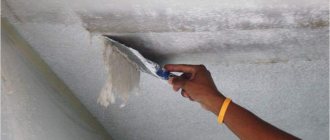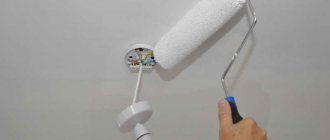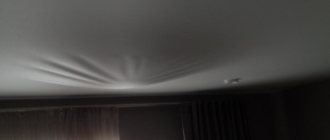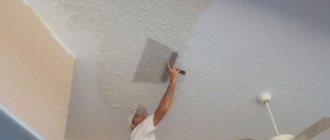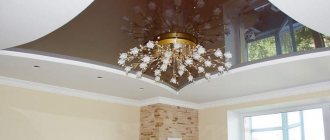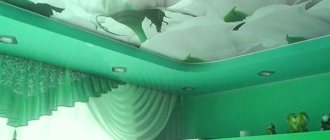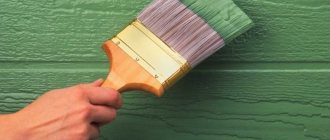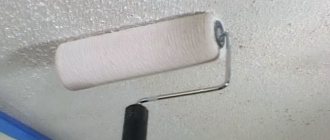The idea of transforming the ceiling cladding has always rested on the question of how dye-resistant the fabric or film material is. There is nothing unusual or new in painting suspended ceilings; almost all types of decorative coatings can be repainted as needed and provided the surface is properly prepared. A wonderful idea, especially since painting a stretch ceiling with a roller is practically no different from painting drywall or a plastered surface.
When using a spray bottle, the process speeds up significantly
Is it possible to paint a suspended ceiling?
Before giving an affirmative answer, it is worth remembering the structure and material of the decorative ceiling trim. Why? Because the material can be painted only if three conditions are met:
- The surface of the stretch ceiling must have micro-roughness. This is important so that the paint layer can adhere to the vinyl or fabric;
- The paint composition must wet the surface, so the paint needs an appropriate surface tension coefficient;
- You can only paint with a composition that, after drying, leaves an elastic film.
In addition, the polyester fiber of fabric ceilings and the vinyl film of tension panels are made of synthetic materials, to which compositions even with a low coefficient of surface tension adhere very poorly.
If we summarize all of the above, it turns out that it is almost impossible to paint a glossy stretch ceiling, but in fact this is not entirely true. Painting smooth varnish ceilings is also quite possible. There are many ways to ensure normal adhesion and retention of paint even on window glass, mirrors, and varnished surfaces.
For your information! True, experts do not recommend painting such paints and varnishes in residential premises due to the high content of toxic components. For home stretch ceilings, one type is recommended - water-based.
Water-based paints are the safest
Is it possible to paint a fabric stretch ceiling?
If we approach the problem formally, then painting a stretch fabric ceiling is possible, but not in all cases. Many manufacturing companies declare the ability to paint and repaint decorative fabric up to 8 times. It's actually not that simple. In theory, you can paint a suspended ceiling with water-based paint. But if you do this with a regular roller or brush, the fabric structure will absorb a huge amount of water and sag under the weight of moisture.
The second negative is the escape of water through the fabric into the ceiling space. If there is no ventilation in the structure of the stretch ceiling, then dampness and mold, at a minimum, dampness of wooden embedded parts is guaranteed.
Therefore, you can paint a fabric suspended ceiling under two conditions:
- Install vents through which you can ventilate the space behind the decorative fabric;
- Use modern pneumatic sprayers for painting.
Important! As a result, the ceiling can be painted an unlimited number of times, with minimal swelling of the canvas and quick drying.
It is believed that a stretch fabric ceiling stretches several times less than vinyl film, so there should not be any special problems with sagging of the surface, provided that the painting technology is followed.
Is it possible to paint a PVC stretch ceiling?
Most experts say that PVC surfaces cannot be painted by hand. At best, you can only paint a matte stretch ceiling. This is not entirely true. There is a fairly large number of non-aqueous organic paints that can be used to paint any PVC plastic, including suspended ceilings.
Such paints are sold in aerosol packaging and are used primarily for tinting car body kits. You can paint the frames of metal-plastic windows.
Paints for PVC
But there is one limitation. Aerosol paint is designed to be applied to a hard surface and always in conditions of good ventilation. The layer thickness is less than 0.1 mm, so there will be no problems with the stretch ceiling sagging.
The paint will adhere to the vinyl ceiling only in the absence of temperature changes, strong drafts and vibrations of the supporting frame. Otherwise, the paint layer laid around the perimeter of the panel will quickly crack and crumble.
Advice! Vinyl ceilings can only be painted with spray paint. Any attempts to apply a layer with a roller or brush are doomed to failure.
The better to paint
The textile fabric used to create such structures can be repainted up to five times. Some manufacturers allow you to perform a similar operation up to ten times, but you shouldn’t get too carried away with this. If you get carried away with such a transformation of the room, you can create too heavy a layer on the canvas and it will inevitably sag.
Coloring cannot be done with any composition. For such work, only acrylic varieties of water-based paints are suitable. It is necessary to choose the most elastic types of them, since when drying, the density of the applied layer and the density of the canvas itself may not match, which will lead to deformation of individual areas or cracking of the coating.
How to choose paint for a stretch ceiling
For PVC surfaces, paints based on chlorinated hydrocarbons and acetone cannot be used. Under the influence of the PVC solvent, the canvas swells, may lose or smudge the pattern, and even become covered with razor bumps. In addition, painting a stretch ceiling with aerosol cans does not provide an even distribution of the coloring toner, spots and stains appear. With synthetics you can only tint a small area of the film, for example, along a wall or around a lamp. There is no question of fully painting the entire surface of the ceiling.
Roller paint
Water-based materials are used to paint stretch fabric ceilings. Some models of polyester fabrics have an additional outer layer of PVC. It is sprayed in order to give the material waterproof qualities. Such ceilings cannot be painted with anything other than water-based and latex paints.
Latex provides the highest quality surface; moreover, the content of rubber-like particles makes the layer softer and more flexible. These paints have good adhesion, so you can use paint rollers and brushes to apply them. You can paint a fabric ceiling with a water-based emulsion from a well-known manufacturer. As a rule, such paints adhere well to the ceiling surface even without a primer.
For high ceilings, a roller is better than a spray gun.
Required tools and materials
To work you will need the following set of tools:
- a medium-sized nap roller will provide better paint coverage of the panel;
- a cuvette or paint bath for impregnating the roller and removing excess composition;
- a narrow paint brush for working on difficult areas;
- masking tape to protect walls at the junction with the ceiling;
- floor covering film;
- dye.
How to paint a suspended ceiling with your own hands
Before starting work, you will need to take care to protect the walls and floor of the room. We cover the space with plastic film, hang paper screens on the walls and secure them with tape. There should be no working electrical or heating devices in the room, all ventilation systems should be turned off, windows and vents should be tightly closed to avoid drafts.
It will take at least 2 hours to cover the ceiling and walls
You need to paint it at least twice. If a paint roller is used, then apply the first layer in a direction parallel to the plane of the window opening, the second - perpendicular to the first.
If a spray gun is used, then the paint and varnish material is applied in transverse stripes, 25-40 cm wide. Painting too widely is inconvenient, and there is a risk of causing stains. The overlap area of the strips must be at least 10 cm.
The suspended ceiling should be dried for at least 24 hours; there should be a time interval of about an hour between applying two layers. Specific time recommendations depend on air temperature and paint viscosity.
Preparing the premises
When working with a surface such as a stretched canvas, you should worry about your safety. There is electrical wiring in the ceiling space, and if you touch it, there is a risk of getting an electric shock. To avoid this, you will need to turn off the electricity in the room before starting work.
In addition, it is necessary to calculate the time in advance so that the room is light, since it will not be possible to illuminate it using the existing light bulb - the electricity will be turned off. It’s worth taking care of the necessary tools in advance.
How to repaint a suspended ceiling
Reapplying paint is considered a simpler and at the same time more complex process. Simple, because there is already a basis on which painting is faster and more comfortable. Difficult, because each subsequent layer of paintwork material makes the tension lining heavier, and marks and lumps appear on the surface of the material.
Light decor is painted against the light
The decorative cladding must be repainted with the same composition with which the surface was coated the previous time. Before re-painting, you will need to remove dust from the stretch fabric with a dry cloth, and carefully rub the areas with damaged coating with a soft rubber eraser.
If the first coat reveals serious defects on the surface, the fabric will need to be dried and rubbed with a stiff sponge before painting further.
Rules for caring for painted stretch ceilings
After painting, the surface becomes more vulnerable to damage. Paint is less resistant to mechanical and thermal stress than vinyl. Therefore, cleaning the tension fabric is performed in two steps. Initially, a layer of soap solution is applied, then washed off without pauses or delays with clean water. In areas of possible contamination, you can wipe with a dry cloth.
Washable without using alkaline solutions
Coloring
Having everything that is indicated in the list, you can start working with the purchased paint. It must be thoroughly stirred so that all its components are evenly mixed. The quality of the created decorative layer depends on how carefully this operation is performed.
Next you need to pour some of the paint into the tray. It has a special ribbed surface on which you need to roll the roller after each time it is wetted with paint. This is done to more evenly cover the roller with the paint composition and remove excess.
You need to paint in several passes. The first layer of paint should be applied across the direction of light entering the room. The second will be applied across the first and parallel to the rays of light entering the room, and each subsequent one should be applied across the previous one. This way you can achieve the most uniform distribution of the composition over the surface. The last, finishing layer should lie in the direction from the window.
Nuances
Unlike standard concrete bases, which can be painted in separate small sections, a suspended ceiling must be painted a little differently - in stripes. That is, you need to apply paint along the entire length of the ceiling at once. The second strip should lie next to the first, slightly overlapping it.
Depending on the type of canvas, it may require more or fewer layers of paint. The lowest quality and cheapest types of suspended ceilings require a more careful approach and may not withstand more than three to four layers.
A high-quality canvas that can withstand a larger amount of paint applied to it. Here the number of layers can reach up to ten. It is also worth considering the area of the room - the larger it is, the heavier the painted surface will be and the higher the risk of sagging.
Source

